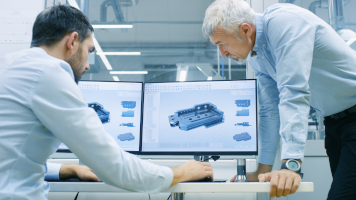Collaborative Robotics
Atreydes studies the possibility of introducing collaborative robots in manual tasks of industrial processes, improving the task repeatability, reducing process times, enhancing the quality and decreasing costs.
Collaborative Robots are intended to work together with operators so that any collisions with them make the robots stop in order not to harm humans, by means of implicit software.

Robotic arm in automated process
Applications
Screwing
Thanks to the use of robotic arms, a uniform and precise screwing can be achieved with the exact tightening torque that each element needs on each occasion. In addition to increasing the quality and reliability of the final product, the employee is freed from repetitive tasks and monotonous.
Computer Numeric Controlled (CNC)
When it comes to machining parts, industrial robots can be used to cut materials with methods such as oxy-cut, water jet, plasma or laser. The robot carries the cutting tool and follows the programmed path continuously and precisely. As for cutting jobs, industrial robots are used in milling work, programming specific paths for each job. They are also common in applications of supply, loading and unloading of different CNC equipment, thus preventing operators from exposing themselves to dangerous situations.
Quality Control
Thanks to its positioning and manipulation capacity, with the correct tools (weighing, ultrasound and vision sensors, such as 2D and 3D artificial vision cameras), it is possible to dispose robots that can carry out the control of already manufactured parts, allowing the control of certain points of a piece. They can also be in charge of the classification of pieces according to certain quality criteria, differentiating between suitable and unsuitable pieces. With the installation of these systems the uniformity and quality of the pieces is guaranteed, obtaining maximum objectivity in the process. In addition, we avoid the shipment of defective parts.
Packaging & Palletizing
Both are basic handling processes. They consist of arranging parts in specific positions, ensuring stability, facilitating subsequent handling and optimizing space. Depending on the application, identical parts, sets of different parts or random loads can be loaded. In these installations, employees are spared unnecessary lifting of heavy objects and repetitive and monotonous tasks.
Injection Molding
Injection molding is the process in which a liquid ceramic, metallic or polymeric material is injected into a closed mold. When the material solidifies, the mold is opened and the part is obtained. Robots, in communication with the injection molding machines, can autonomously load and unload the machines, performing fast and accurate work.
Assembly
As in other applications, thanks to the appropriate tools and adaptation, assembly of plastic and metal parts can be performed with fastening tasks, such as press-fitting of parts, assembly, insertion of accessories and so on. In these cases, the robot can work autonomously or assist the assembly staff.
Sticking
We know that a robot can repeat a programmed path continuously and accurately. Well, this allows for uniform distribution of the adhesive on the product, reducing the amount of waste while obtaining a precise and consistent application of material.
Pick & Place
In the industrial world, Pick & Place is the process of picking a product from one location and placing it in another location. It is very common to see robots collaborating with operators or in an automated way removing material from pallets, working on production lines, loading and unloading parts.
Laboratory Tests and Analyses
There are also robots performing various tests to determine the service life of products and accessories such as controls or switches. Accuracy, uniformity and repeatability of a situation provide a good basis for data collection and analysis.
Polishing
In polishing, buffing and sanding applications, the robots apply the precise force on their own, thanks to the control of all their axes and applying the correct torque, resulting in uniform parts of identical quality.
Welding
Different welding jobs can be performed, such as spot welding, arc welding, TIG, MIG, plasma welding, etc., depending on the tool used. The possibility of continuous welding paths reduces the process times and thanks to accuracy, high quality is achieved throughout the process.
Our Added Value
Our high added value offers the best solution for our customers, combining different technical areas, computer applications and technologies to optimize their final products.
Control Systems encompass collaborative robots making communication networks and integrating them in productive processes. Also, collaborative robots have a less powerful control structure to interact with sensors and actuators to incorporate external tasks to the own productive process through them.






